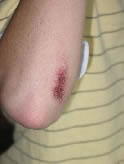Skin Foreign Body
Skin Foreign Body
Does this describe your symptoms? |
Click image for more info |
Definition
Symptoms of a Foreign Body in the Skin
Types of Foreign Bodies
Need for Removal
Pencil Punctures
|
When to Call Your Doctor |
Call Your Doctor Now (night or day) If |
|
|
|
Call Your Doctor Within 24 Hours (between 9 am and 4 pm) If |
|
|
|
Call Your Doctor During Weekday Office Hours If |
|
|
|
Self Care at Home If |
|
|
HOME CARE ADVICE FOR MINOR SPLINTERS OR SLIVERS |
Removing Slivers, Splinters, and Thorns
Needle and Tweezers:
You can remove slivers, splinters, or thorns with a needle and tweezers.
Check the tweezers beforehand to be certain the ends (pickups) meet exactly (If they do not, bend them).
Sterilize the tools with rubbing alcohol or a flame.
Clean the skin surrounding the sliver briefly with rubbing alcohol before trying to remove it. Be careful not to push the splinter in deeper. If you don't have rubbing alcohol, use soap and water, but don't soak the area if FB is wood (Reason: can cause swelling of the splinter).
Step-by-Step Instructions:
STEP 1: Use the needle to completely expose the end of the sliver. Use good lighting. A magnifying glass may help.
STEP 2: Then grasp the end firmly with the tweezers and pull it out at the same angle that it went in. Getting a good grip the first time is especially important with slivers that go in perpendicular to the skin or those trapped under the fingernail.
Additional Instructions:
For slivers under a fingernail, sometimes a wedge of the nail must be cut away with fine scissors to expose the end of the sliver.
Superficial horizontal slivers (where you can see all of it) usually can be removed by pulling on the end. If the end breaks off, open the skin with a sterile needle along the length of the sliver and flick it out.
Antibiotic Ointment: Apply an antibiotic ointment (OTC) to the area once after removal to reduce the risk of infection.
Tetanus Booster:
If your last tetanus shot was given over 10 years ago, you need a booster.
You should try to get this booster shot within the next couple days.
Call Your Doctor If:
Can't get it all out
Removed it, but pain becomes worse
Starts to look infected
You become worse.
Removing Tiny Plant Stickers (e.g., cactus pines, stinging nettles) or Fiberglass Spicules
Tiny Plant Stickers: Plant stickers (e.g., stinging nettle), cactus spines, or fiberglass spicules are difficult to remove. Usually they break when pressure is applied with tweezers.
Tape: First try to remove the small spines or spicules by touching the area lightly with packaging tape or another very sticky tape.
Wax Hair Remover (If tape does not work):
Warm up the wax in your microwave for 10 seconds and apply a layer over the spicules (or fiberglass). Cover it with the cloth strip that came in the hair remover package. Let it air dry for 5 minutes or accelerate the process with a hair dryer. Then peel it off with the spicules. Most will be removed. The others will usually work themselves out with normal shedding of the skin.
You can also try all-purpose white glue, but it's far less effective.
Tetanus Booster:
If your last tetanus shot was given over 10 years ago, you need a booster.
You should try to get this booster shot within the next couple days.
Call Your Doctor If:
Can't get it all out and it's painful
Starts to look infected
You become worse.
Tiny Superficial Pain-free Slivers
Tiny, Pain-Free Slivers: If superficial slivers are numerous, tiny, and pain-free, they can be left in. Eventually they will work their way out with normal shedding of the skin or the body will reject them by forming a tiny little pimple.
Tetanus Booster:
If your last tetanus shot was given over 10 years ago, you need a booster.
You should try to get this booster shot within the next couple days.
Call Your Doctor If:
Starts to look infected
You become worse.
And remember, contact your doctor if you develop any of the "Call Your Doctor" symptoms.
Updated:
March 22, 2017





